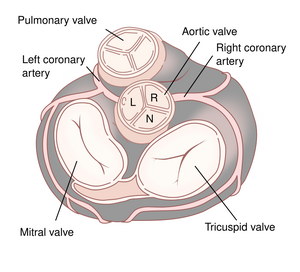Aortic Valve
Anatomy
The normal aortic valve consists of three equally sized valve cusps, namely the right coronary cusp (R), the left coronary cusp (L) and the non-coronary cusp (N).
With 2D echocardiography, the valve can be assessed in the PLAX, where one sees the RCC and the NCC. In a normal aortic tricuspid valve, the closure line is between the RCC and NCC and usually in the center of the aortic valve ring. However, the aortic valve can be even better assessed in the PSAXao, where the three cusps in systole almost form a circle and in diastole an inverted Mercedes-Benz logo. Assessing the number of cusps is done in systole, because the valve is open and because in the closed position raphes can be misinterpreted. With 3D echocardiography you can now also get wonderful images of the aortic valve.
| Video |
| 3D (TEE) view of the aortic valve to exclude vegetations. |
|---|
Aortic valve variants (PLAX ao)
| Video | Video |
| Tricuspid (normal) | Bicuspid |
|---|---|
| Video | Video |
| Quadricuspide | Unicuspide |
Bicuspid aortic valve
The bicuspid aortic valve is the most common cardiac valve abnormality. Here are two leaflets fused during the development. A bicuspid aortic valve occurs in 1-2% of the population and twice as often in men compared to women.
A bicuspid aortic valve can be hereditary, both familial clustering and isolated valve defects are documented. The incidence of bicuspid aortic valve may reach 10% in certain families. A bicuspid aortic valve is often associated with other congenital heart defects, including coarctation of the aorta. Usually there is a fusion between the LCC and RCC (70%). In many cases, the bicuspid aortic valve does not cause any problems. Later in life, the valve will calcify early causing a stenosis and possibly also regurgitation through malcoaptation of the affected cusps.
Stenosis
| Causes | |
| Supravalvulair:
(usually congenital) |
|
| Valvular: |
|
| Subvalvular: |
|
Some patients have no symptoms, but sudden, unexpected death may be the first phenomenon. Fatigue, shortness of breath and lack of oxygen during exertion, chest pain and dizziness and fainting during exercise are other symptoms. The left ventricle must develop higher pressures in aortic valve stenosis in order to generate an adequate blood pressure. Depending on the severity and cause of the problem, a valve replacement may be indicated.
Click here for quantification of aortic valve stenosis.
Insufficiency
| Causes | |
| Congenital |
|
| Risk of damage to the aortic valve |
|
| Aortic dilation |
|
A serious aortic regurgitation causes a volume overload of the left ventricle. Since the blood that has just been ejected, returns immediately and causes left ventricular overload and subsequently heart failure may occur. Patients complain of fatigue and shortness of breath. The valve, and possibly a part of the aortic arch, may be replaced.
Click here for quantification of aortic valve insufficiency.
